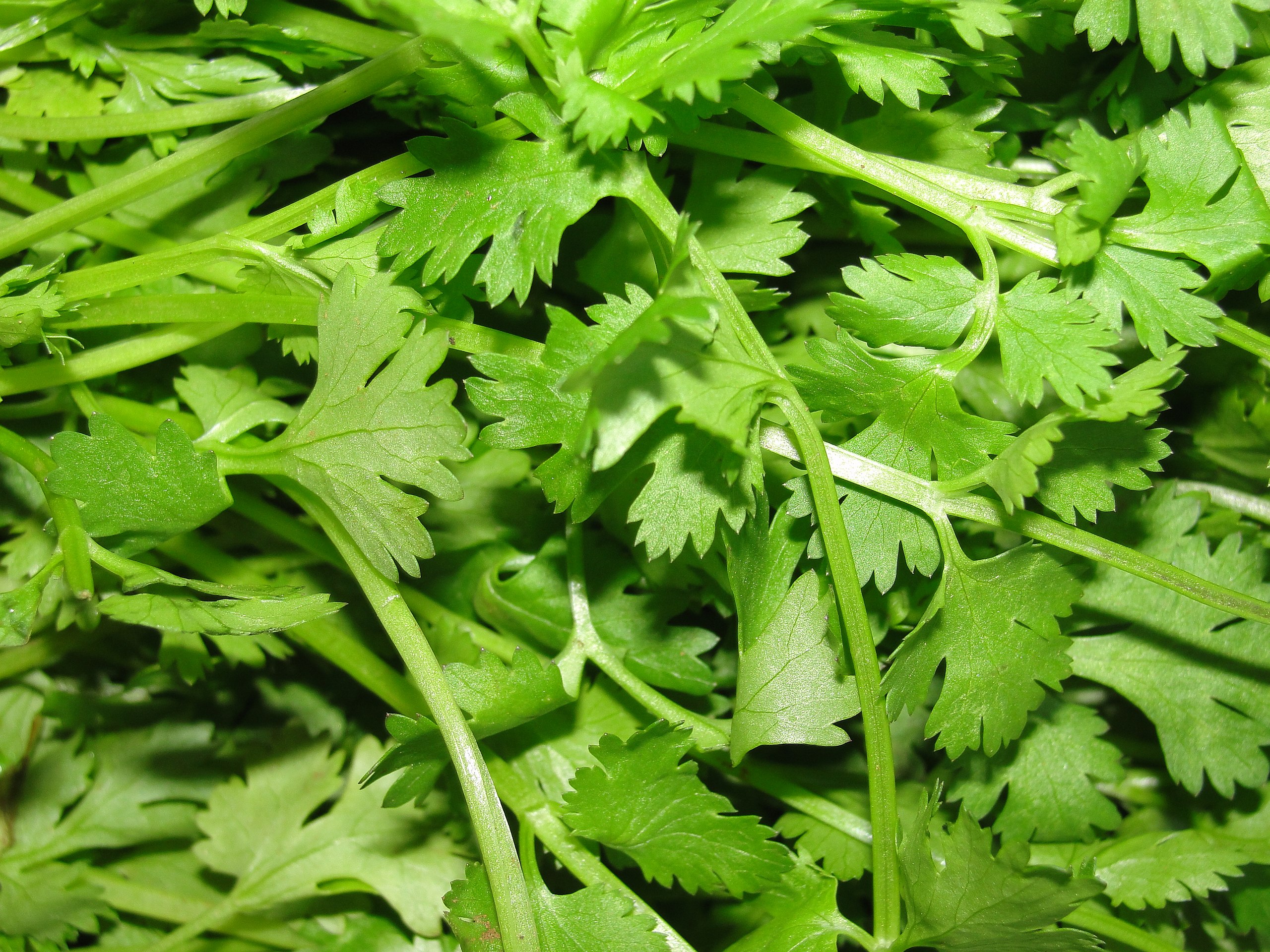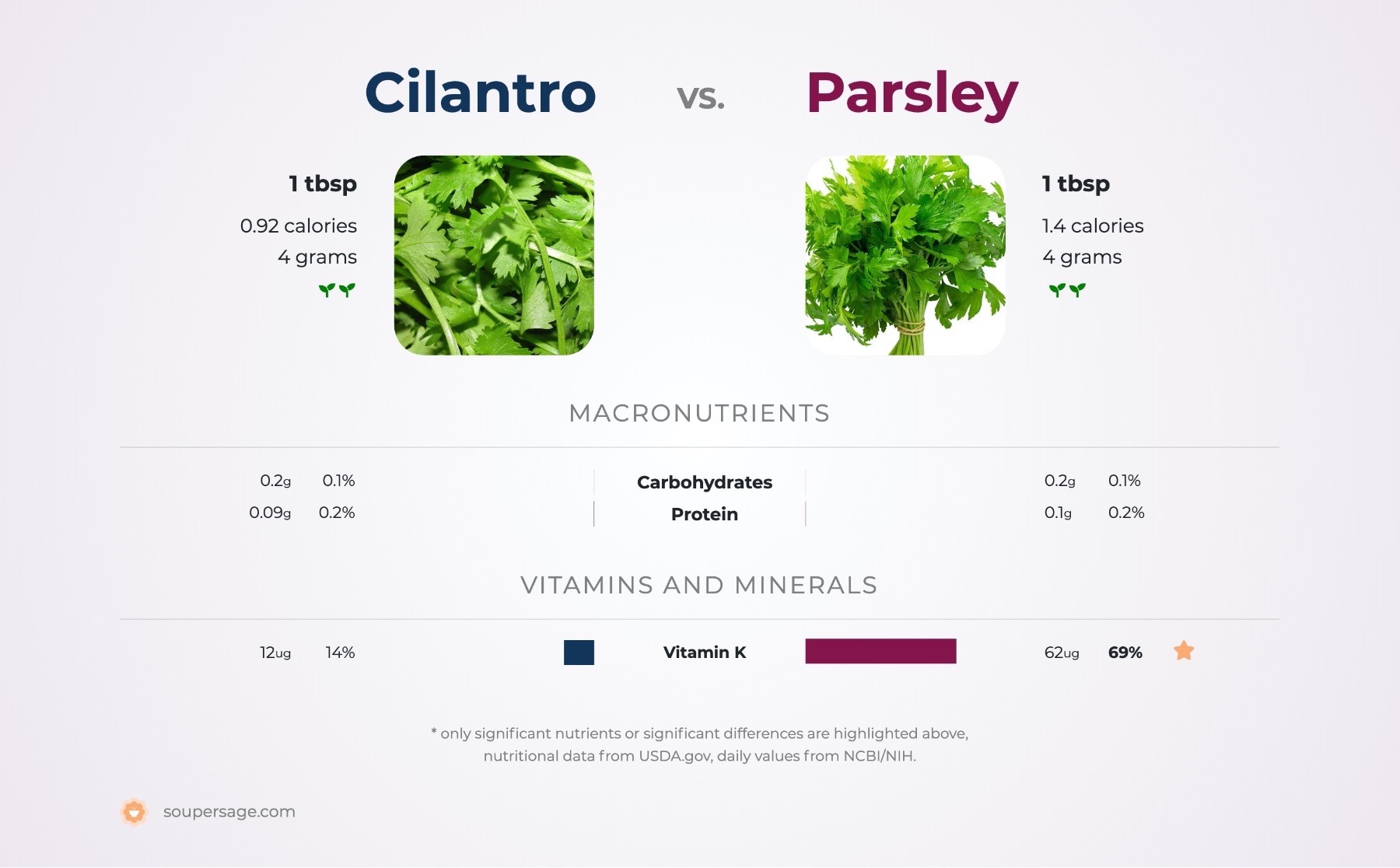Cilantro vs. Parsley
Nutrition comparison of Cilantro and Parsley
Ever wonder how your favorite foods stack up against each other in terms of nutrition?
We compared the nutritional contents of
cilantro
versus
parsley
(100g each)
below using 2020 USDA and NIH data[1].
For a quick recap of significant nutrients and differences in cilantro and parsley:
- Both cilantro and parsley are high in Vitamin A, Vitamin C, Vitamin K, calcium, dietary fiber and potassium.
- Cilantro has more alpha-carotene than parsley, however, parsley contains more lutein + zeaxanthin than cilantro.
- Parsley has more folate.
- Parsley is an excellent source of iron.
USDA sources for nutritional information: Cilantro (Coriander (cilantro) leaves, raw) and Parsley (Parsley, fresh) . Have a correction or suggestions? Shoot us an email.
Calories and Carbs
calories
Cilantro and parsley contain similar amounts of calories - cilantro has 23 calories per 100 grams and parsley has 36 calories.
For macronutrient ratios, cilantro is heavier in protein, lighter in carbs and similar to parsley for fat. Cilantro has a macronutrient ratio of 50:50:0 and for parsley, 33:67:0 for protein, carbohydrates and fat from calories.
Macro Ratios from Calories:
| Cilantro | Parsley | |
|---|---|---|
| Protein | 50% | 33% |
| Carbohydrates | 50% | 67% |
| Fat | ~ | ~ |
| Alcohol | ~ | ~ |
carbohydrates
Cilantro and parsley contain similar amounts of carbs - cilantro has 3.7g of total carbs per 100 grams and parsley has 6.3g of carbohydrates.
dietary fiber
Both cilantro and parsley are high in dietary fiber. Parsley has 18% more dietary fiber than cilantro - cilantro has 2.8g of dietary fiber per 100 grams and parsley has 3.3g of dietary fiber.
sugar
Cilantro and parsley contain similar amounts of sugar - cilantro has 0.87g of sugar per 100 grams and parsley has 0.85g of sugar.
Protein
protein
Cilantro and parsley contain similar amounts of protein - cilantro has 2.1g of protein per 100 grams and parsley has 3g of protein.
Fat
saturated fat
Both cilantro and parsley are low in saturated fat - cilantro has 0.01g of saturated fat per 100 grams and parsley has 0.13g of saturated fat.
Vitamins
Vitamin C
Both cilantro and parsley are high in Vitamin C. Parsley has 393% more Vitamin C than cilantro - cilantro has 27mg of Vitamin C per 100 grams and parsley has 133mg of Vitamin C.
Vitamin A
Both cilantro and parsley are high in Vitamin A. Parsley has 25% more Vitamin A than cilantro - cilantro has 337ug of Vitamin A per 100 grams and parsley has 421ug of Vitamin A.
Vitamin E
Cilantro has 233% more Vitamin E than parsley - cilantro has 2.5mg of Vitamin E per 100 grams and parsley has 0.75mg of Vitamin E.
Vitamin K
Both cilantro and parsley are high in Vitamin K. Parsley has 429% more Vitamin K than cilantro - cilantro has 310ug of Vitamin K per 100 grams and parsley has 1640ug of Vitamin K.
The B Vitamins
Parsley has more folate. Both cilantro and parsley contain significant amounts of thiamin, riboflavin, niacin, pantothenic acid and Vitamin B6.
| Cilantro | Parsley | |
|---|---|---|
| Thiamin | 0.067 MG | 0.086 MG |
| Riboflavin | 0.162 MG | 0.098 MG |
| Niacin | 1.114 MG | 1.313 MG |
| Pantothenic acid | 0.57 MG | 0.4 MG |
| Vitamin B6 | 0.149 MG | 0.09 MG |
| Folate | 62 UG | 152 UG |
Minerals
calcium
Both cilantro and parsley are high in calcium. Parsley has 106% more calcium than cilantro - cilantro has 67mg of calcium per 100 grams and parsley has 138mg of calcium.
iron
Parsley is an excellent source of iron and it has 250% more iron than cilantro - cilantro has 1.8mg of iron per 100 grams and parsley has 6.2mg of iron.
potassium
Both cilantro and parsley are high in potassium. Cilantro is very similar to cilantro for potassium - cilantro has 521mg of potassium per 100 grams and parsley has 554mg of potassium.
Antioxidants and Phytonutrients
flavonoids
Naturally occuring in fruits and vegetables, flavonoids are associated with many health benefits and used in a variety of medicinal and pharmaceutical applications. [2][3]
For specific flavonoid compounds, cilantro has more quercetin than parsley per 100 grams, however, parsley contains more apigenin, luteolin, kaempferol and myricetin than cilantro per 100 grams.
| Cilantro | Parsley | |
|---|---|---|
| Quercetin | 52.9 mg | 0.28 mg |
| apigenin | ~ | 215.46 mg |
| luteolin | ~ | 1.09 mg |
| kaempferol | ~ | 1.49 mg |
| myricetin | ~ | 14.84 mg |
carotenoids
Carotenoids are micronutrients commonly found in plants and some animal products. An example is beta-carotene, the notable carotenoid which is a popular source of Vitamin A.[4][5]
For specific types of carotenoids, cilantro has more alpha-carotene than parsley per 100 grams, however, parsley contains more lutein + zeaxanthin than cilantro per 100 grams. Both cilantro and parsley contain significant amounts of beta-carotene.
| Cilantro | Parsley | |
|---|---|---|
| beta-carotene | 3930 UG | 5054 UG |
| alpha-carotene | 36 UG | ~ |
| lutein + zeaxanthin | 865 UG | 5561 UG |
Omega-3 and Omega-6
omega 6s
Comparing omega-6 fatty acids, parsley has more linoleic acid than cilantro per 100 grams.
| Cilantro | Parsley | |
|---|---|---|
| linoleic acid | 0.04 G | 0.115 G |
| Total | 0.04 G | 0.115 G |
Customize your serving size
The comparison below is by common portions, e.g. cups, packages. You can also see a more concrete comparison by weight at equal weight (by grams) comparison.
Cilantro g
()
|
Daily Values (%) |
Parsley g
()
|
|||||
|---|---|---|---|---|---|---|---|
| KCAL % |
|
5% | calories | 5% |
|
KCAL % | |
| G % |
|
5% | carbohydrates | 5% |
|
G % | |
| G % |
|
5% | dietary fiber | 5% |
|
G % | |
| G | 5% | sugar | 5% | G | |||
| G % |
|
5% | total fat | 5% |
|
G % | |
| G % |
|
5% | saturated fat | 5% |
|
G % | |
| G | 5% | monounsaturated fat | 5% | G | |||
| G | 5% | polyunsaturated fat | 5% | G | |||
| G | 5% | trans fat | 5% | G | |||
| MG | 5% | cholesterol | 5% | MG | |||
| MG % |
|
5% | sodium | 5% |
|
MG % | |
| 5% | Vitamins and Minerals | 5% | |||||
| UG % |
|
5% | Vitamin A | 5% |
|
UG % | |
| MG % |
|
5% | Vitamin C | 5% |
|
MG % | |
| IU % |
|
5% | Vitamin D | 5% |
|
IU % | |
| MG % |
|
5% | calcium | 5% |
|
MG % | |
| MG % |
|
5% | iron | 5% |
|
MG % | |
| MG % |
|
5% | magnesium | 5% |
|
MG % | |
| MG % |
|
5% | potassium | 5% |
|
MG % | |
| MG % |
|
5% | thiamin (Vit B1) | 5% |
|
MG % | |
| MG % |
|
5% | riboflavin (Vit B2) | 5% |
|
MG % | |
| MG % |
|
5% | niacin (Vit B3) | 5% |
|
MG % | |
| MG % |
|
5% | Vitamin B6 | 5% |
|
MG % | |
| MG % |
|
5% | pantothenic acid (Vit B5) | 5% |
|
MG % | |
| UG % |
|
5% | folate (Vit B9) | 5% |
|
UG % | |
| UG % |
|
5% | Vitamin B12 | 5% |
|
UG % | |
| MG % |
|
5% | Vitamin E | 5% |
|
MG % | |
| UG % |
|
5% | Vitamin K | 5% |
|
UG % | |
| G % |
|
5% | protein | 5% |
|
G % | |
| UG % |
|
5% | biotin (Vit B7) | 5% |
|
UG % | |
| MG % |
|
5% | choline | 5% |
|
MG % | |
| MG % |
|
5% | chlorine | 5% |
|
MG % | |
| UG % |
|
5% | chromium | 5% |
|
UG % | |
| MG % |
|
5% | copper | 5% |
|
MG % | |
| UG % |
|
5% | fluoride | 5% |
|
UG % | |
| UG % |
|
5% | iodine | 5% |
|
UG % | |
| MG % |
|
5% | manganese | 5% |
|
MG % | |
| UG % |
|
5% | molybdenum | 5% |
|
UG % | |
| MG % |
|
5% | phosphorus | 5% |
|
MG % | |
| UG % |
|
5% | selenium | 5% |
|
UG % | |
| MG % |
|
5% | zinc | 5% |
|
MG % | |
| G | 5% | Water | 5% | G | |||
| G | 5% | Starch | 5% | G | |||
| G | 5% | Alcohol | 5% | G | |||
FAQ
Does cilantro or parsley contain more calories in 100 grams?Cilantro and parsley contain similar amounts of calories - cilantro has 23 calories in 100g and parsley has 36 calories.
Is cilantro or parsley better for protein?
Cilantro and parsley contain similar amounts of protein - cilantro has 2.1g of protein per 100 grams and parsley has 3g of protein.
Does cilantro or parsley have more carbohydrates?
By weight, cilantro and parsley contain similar amounts of carbs - cilantro has 3.7g of carbs for 100g and parsley has 6.3g of carbohydrates.
Does cilantro or parsley contain more calcium?
Both cilantro and parsley are high in calcium. Parsley has 110% more calcium than cilantro - cilantro has 67mg of calcium in 100 grams and parsley has 138mg of calcium.
Does cilantro or parsley contain more iron?
Parsley is an abundant source of iron and it has 250% more iron than cilantro - cilantro has 1.8mg of iron in 100 grams and parsley has 6.2mg of iron.
Does cilantro or parsley contain more potassium?
Both cilantro and parsley are high in potassium. Cilantro is very similar to cilantro for potassium - cilantro has 521mg of potassium in 100 grams and parsley has 554mg of potassium.


